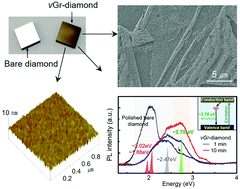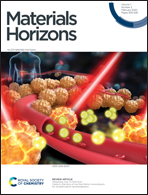The surface hybridization of diamond with vertical graphene: a new route to diamond electronics†
Abstract
Herein a method is proposed for engineering the electronic properties (including the band structure) of diamond via surface hybridization with graphene. Graphene layers (5–50 nm in thickness) were grown vertically onto a polished 〈110〉 textured polycrystalline diamond plate (1 × 1 cm2) (vGr-diamond) at ∼1300 °C via hydrogen plasma etching in a chemical vapor deposition (CVD) chamber. Due to the crystallographic relationship, the graphene layers embed at an angle of 30° to the diamond surface comprising the (110) planes. The epitaxial relationship is demonstrated via low angle X-ray diffraction (XRD), the XRD rocking curve, Raman and scanning electron microscopy. With hybridization, the diamond sample reveals a strong photoluminescent (PL) signal at ∼2.78 eV (∼450 nm). The peak was assigned to the ‘interface defects’ of the vGr-diamond hybrid structure, which are a type of ‘surface defect’ of the CVD diamond that generates a peak at ∼2.69 eV. The blue shift (∼90 meV) of the interface defects is due to the compressive strain of ∼3% applied to the interface atoms. Simulations indicate that the hybrid structures possess a finite band gap of 1.85–0.25 eV, which decreases upon increasing the thickness of the graphene layers to ∼1.4 nm. The appearance of a small band gap was attributed to the compressive strain. These findings may provide a route for diamond to become a platform for next generation and extreme electronic devices.



 Please wait while we load your content...
Please wait while we load your content...